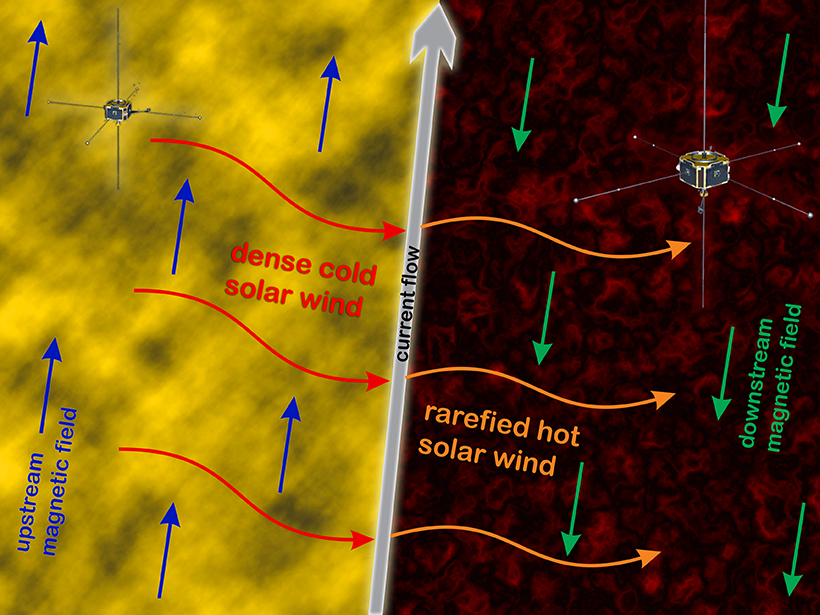Source: Journal of Geophysical Research: Space Physics
The phrase “solar wind” may conjure up images of streams of protons wafting off the Sun and floating into space like a gentle breeze. But these particles, traveling at upward of 400 kilometers per second, more often resemble a raging, turbulent current, with swirls and eddies.
Some of the most dramatic features of the solar wind are discontinuities, where the magnetic field inside the stream abruptly changes direction.
These discontinuities are analogous to wind shear that aircraft encounter in Earth’s atmosphere, and similarly, their presence usually means there’s more turbulence nearby. Strong electric currents flow near a discontinuity, and these are an important generator of turbulence throughout the solar wind.
But investigating these dynamics in detail is not easy and requires data from multiple spacecraft that straddle such a boundary.
Now Artemyev et al. have used data from NASA’s Acceleration, Reconnection, Turbulence and Electrodynamics of the Moon’s Interaction with the Sun (ARTEMIS) mission, a pair of satellites that orbit the Moon and have a unique vantage point in the pristine solar wind. By mining data from its suite of instruments on the solar wind, its plasma, and its magnetic field, the team identified roughly 300 discontinuities and analyzed their structure.
They found that the currents that accompany solar wind discontinuities are actually two currents in one: They have a dual-layer structure, with an intense, but thin, layer of current flowing within a thicker one. The thin, embedded layer is typically on the order of a few thousand kilometers thick, whereas the weaker outer layer can span hundreds of thousands of kilometers.
Intriguingly, the team also found that the behavior of solar wind discontinuities doesn’t fit neatly into theoretical categories.
In fluid dynamics theory, discontinuities like those in the solar wind come in two forms. In some, plasma flows in the same direction but at different speeds, so that no plasma flows across the boundary—a so-called tangential discontinuity. In others, the discontinuity is a kind of shock wave, so that plasma can cross the boundary but is sent off in another direction as it does—a rotational discontinuity.
But the discontinuities the team observed look like a combination of both categories. The density and temperature of the solar wind’s plasma change dramatically from one side of the discontinuity to another, suggesting a stark, tangential discontinuity where no particles could cross. Yet the team also observed that some electrons—those with energies of hundreds of electron volts or higher—could freely cross over the boundary, as in a rotational discontinuity.
The key to resolving this contradiction may lie in the motion of individual plasma particles as they gyrate through space under the influence of electric and magnetic fields, the authors write. A drop in electric potential could create conditions that appear to create separate groups of plasma—like one layer embedded in another—yet still allow some particles to cross over the discontinuity. Investigating this possibility will require theorists to branch out from treating the solar wind as a pure fluid and to use models that consider the motions of individual particles, the team writes. (Journal of Geophysical Research: Space Physics, https://doi.org/10.1029/2019JA026597, 2019)
—Mark Zastrow, Freelance Writer
Citation:
Zastrow, M. (2019), Understanding the turbulent nature of the solar wind, Eos, 100, https://doi.org/10.1029/2019EO126329. Published on 13 June 2019.
Text © 2019. The authors. CC BY-NC-ND 3.0
Except where otherwise noted, images are subject to copyright. Any reuse without express permission from the copyright owner is prohibited.

